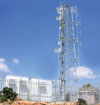

To cater for the rapidly growing wireless environment, Webb Industries has substantially expanded its footprint of high-sites in Gauteng and surrounding provinces.
“As the authorities increasingly regulate the burgeoning number of base-station facilities around the country, the demand for space on our high-sites has ballooned quite considerably,” says Dave Beeming, Webb’s high-sites divisional manager. “And by ‘wholesaling’ this kind of service we are helping to make our clients’ businesses more efficient.”
Webb’s footprint of high-sites now extends from Vereeniging and Parys in the south, to Pretoria and Hartbeespoort in the north; from Hekpoort in the west to Bronkhorstpruit and Nigel in the east.
“We literally have Gauteng surrounded, but the bulk of our sites are still in the Johannesburg, Midrand, Pretoria corridor where most of the demand is,” says Beeming, adding that the prime topographical locations of Webb’s sites means excellent coverage and line-of-sight opportunities for its clients’ network planning and coverage requirements. Our high-sites are designed as multi-user facilities to facilitate the increased number of users,” he says. “And we will continue to expand our capacity and network footprint to meet the specific needs of our current and future clients.”
Beeming says that in addition, Webb provides a comprehensive range of radio site management and technical services for a wide range of clients in the radio communications industry. “Systems installed range from two-way radio systems, broadband Internet access and wireless networks to GSM, microwave and regulatory monitoring systems.”
Users of Webb’s high-site facilities include organisations such as ICASA, Telkom, Neotel, Transtel, Vodacom, MTN, Cell C, Sentech, Netstar, Tracker and various security companies and wireless Internet access providers.
“In essence, “says Beeming, “our business is to create the facility for operators to concentrate on selling their product – communication services – rather than getting involved in the extraneous infrastructure development issues, which for them are time consuming and prohibitively expensive – both in terms of initial capital expenditure and ongoing operational/maintenance costs. The net result is that by using our sites they can stick to their core business and be significantly more efficient and cost effective.
“Developing and managing one’s own high-site is an arduous and time consuming task. Local authorities do not want a proliferation of these facilities and finding good locations is becoming increasingly difficult. The answer is the co-location of users on sites like ours,” he concluded.

© Technews Publishing (Pty) Ltd | All Rights Reserved